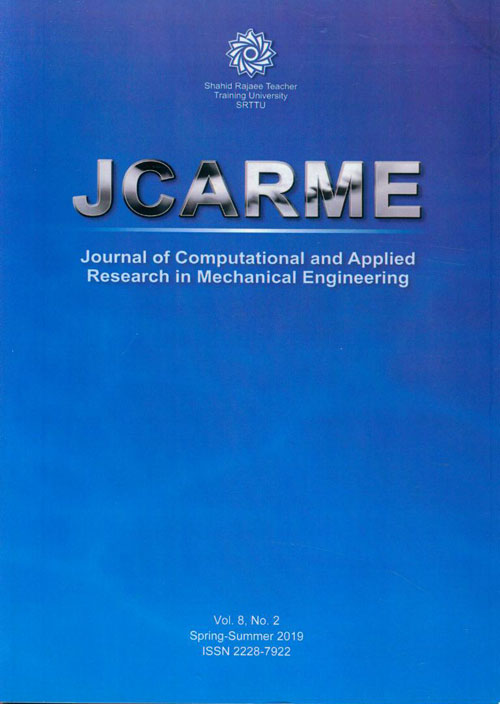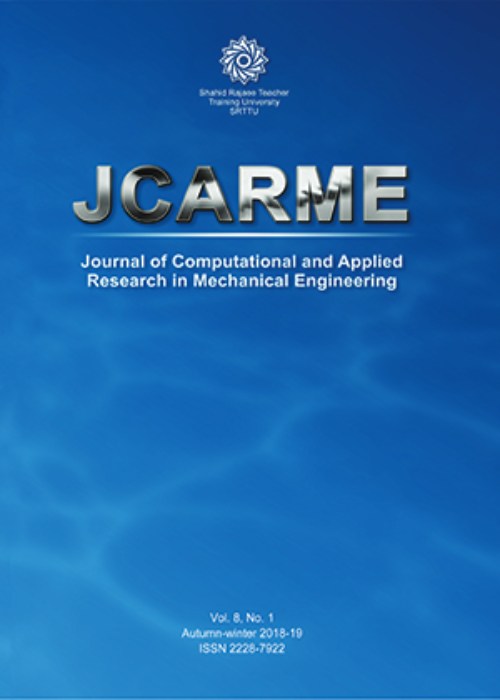فهرست مطالب

Journal of Computational and Applied Research in Mechanical Engineering
Volume:8 Issue: 2, Winter and Spring 2019
- 120 صفحه،
- تاریخ انتشار: 1397/11/28
- تعداد عناوین: 10
-
-
Pages 121-132
-
Pages 133-144Due to various advantages of Wheeled Mobile Robots (WMRs), many researchers have focused to solve their challenges. The automatic motion control of such robots is an attractive problem and is one of the issues which should carefully be examined. In the current paper, the trajectory tracking problem of WMRs which are actuated by two independent electrical motors is deliberated. To this end, and also, computer simulation of the system, first the system model is derived at the level of kinematics. The system model is nonholonomic. Then a simple non-mode-based controller based on fuzzy logic will be proposed. The control input resulted from fuzzy logic will then be corrected to fulfill the actuation saturation limits and non-slipping condition. To prove the efficiency of the suggested controller, its response, in terms of the required computational time burden and tracking error, will be compared with a previously suggested method. The obtained simulation results support the superiority of fuzzy based method over a previous study in terms of the considered measures.Keywords: Wheeled mobile robot, Motion control, Fuzzy logic, Predictive control
-
Pages 145-151Lateral velocity has very backbone position in the railway vehicle wheelset dynamics as it usually becomes cause of derailment by sliding due to insufficient adhesion ratio. This impropriate balance is pretext owing to contamination and weather procures the disturbances. This perturbation makes hindrances in proper running of wheelset on track. To analyze the noise, Kalman filter is used based upon the railway dynamic modeling to estimate the actual signals to control the noise by measurement. Thus error percentage is also computed to detect the slippage by adhesion on applicable analysis of creep co-efficient.
The motion and velocity of Lateral and yaw analysis for railway vehicle wheelset is of great importance for the slip and sliding point of view. As usually hit has been observed that fatal accidents, destruction of railway vehicle with railway tracks and damage of costly lives happen due to improper control on the lateral and yaw railway dynamic system with chaos management as well as technical point of view. Since controllable estimated lateral velocity assures minimum wheel slide.Keywords: Creep force, creepage, creep coefficient, adhesion, noise, coincity -
Pages 153-164Using experimental models along with conducting numerical analysis have been widely used in performance recognition and optimization of hydraulic equipments. Numerical modeling has lower cost rather than experimental one; however practical tests are commonly used because of the hydraulic structure importance especially in dams. Meanwhile numerical methods could be used for future designs through validating numerical models. In this paper, volume of fluid method, VOF, has been employed to simulate the free surface flow at the dam bottom outlet form bell mouth section up to the downstream channel. Since the flow through the gates has high Reynolds number, the standard k-ε and also Reynolds Stress Model, RSM, turbulence models is used and the results compared. The discharge coefficient and the ventilated air velocity through the vents is computed numerically and compared with the experimental data. Comparison between the experimental data and numerical simulation results shows good compatibility, especially in RSM turbulence model rather than k-ε turbulence model. The results show that the maximum error percentage in simulation of the discharge coefficient and the ventilated air velocity is 9% and 3% respectively.Keywords: Numerical simulation, Dam bottom outlet, Volume of fluid, Ventilation
-
Pages 165-176Inherent nonlinearities like, deadband, stiction and hysteresis in control valves degenerate plant performance. Valve stiction standouts as a more widely recognized reason for poor execution in control loops. Measurement of valve stiction is essential to maintain scheduling. For industrial scenarios, loss of execution due to nonlinearity in control valves is an imperative issue that should be tackled. Thus, an intelligent technique is required for automated execution, observation and enhancement. The paper shows the creative utilization of an intelligent controller for nonlinearity diagnosis in control valves. This is a Fuzzy Gain Scheduling (FGS) PID smart controller that tunes its gain parameters in real time to manage a control valve’s inherent nonlinearity. The viability of the FGS PID controller is experimentally verified in a laboratory scale plant. An execution comparison between FGS PID and classical PID controllers are undertaken for their set point following and disturbance rejection at different operating points. Experimental results show that the FGS PID controller outperforms the classical PID controller for all explored cases effectively managing stiction based oscillation in the controller output.Keywords: Pneumatic control valve, deadband, stiction, hysteresis, fuzzy gain scheduling, pressure control system
-
Pages 177-187Liquid sloshing is a common phenomenon in the transporting of liquid tanks. Liquid waves lead to fluctuating forces on the tank wall. If these fluctuations are not predicted or controlled, they can lead to large forces and momentum. Baffles can control liquid sloshing fluctuations. One numerical method, widely used to model the liquid sloshing phenomena is Smoothed Particle Hydrodynamics (SPH). Because of its Lagrangian nature, SPH is suitable for simulating free surface flow. In the present study, a relatively accurate Incompressible SPH (ISPH) method improved by kernel gradient correction tensors, particle shifting algorithms, turbulence viscosity calculations, and free surface particle detectors is applied for the free surface flow modeling. In comparison to the other SPH Simulations and experimental data, these results show that the present algorithm is effective for simulating free surface problems. The present algorithm has been applied to simulate liquid sloshing phenomena, while the aim of this study is the investigation of vertical and horizontal baffle effects on the control and damping of liquid sloshing. Results show that for vertical baffles, baffle size has a major role in sloshing fluctuation damping. For horizontal baffles, also including size, the baffle base position has a significant role in liquid sloshing fluctuation damping. When horizontal baffle is near the free surface, sloshing fluctuation-damping increases.Keywords: SPH, vertical baffle, Horizontal baffle, Free Surface
-
Pages 189-198Formation of shock waves has an important role in supercritical flows studies. These waves are often occurring during passage of supercritical flow in the non-prismatic channels. In the present study, the effect of length of contraction wall of open-channel for two different geometries (1.5 m and 0.5 m) and fixed contraction ratio was investigated on hydraulic parameters of shock waves using experimental model (models 1 and 2). For achieving to this goal, values of height and instantaneous velocity were measured in various points of shock waves observed in contractions for four Froude Numbers. In general, non-uniform distribution of velocity and turbulence intensity profiles were completely clear. Comparing results of models 1 and 2, show that the height and velocity values of formed waves in the model 2 is so much more than the model 1. Also, motion of the shock waves was accompanied with longitude gradient decrease of turbulence kinetic energy. The results of the present research can be very useful for designer engineers.Keywords: Contraction, Shock wave, Supercritical flow, Turbulence intensity, Turbulence kinetic energy
-
Pages 199-210Laminar mixing of glycerin in a chaotic mixer is carried by means of the blob deformation method. The mixer was a cylindrical vessel with two rotational blades which move along two different circular paths with a stepwise motion protocol. The flow visualization was performed by marking of the free surface of the flow with a tracer. The effects of controlling parameters such as rotational speed of blades, blades length, and rotational speed amplitude on mixing efficiency and time were analyzed by measuring of the area covered by the tracer. The results revealed that increasing rotational speed intensifies stretching and folding phenomenon, and consequently better mixing can be obtained. Also, the better condition in flow kinematic was provided to blend as stepwise motion protocol with wider amplitude adopted. A reduction in mixing time could be observed as the blades with longer length were used. In addition, it was also found that the promotion of mixing by rotational speed is more effective than that of two other parameters. The quantitative data and qualitative observations proved the potential of proposed chaotic mixer in wide range of industrial processes including chemical reaction and food processing in which laminar mixing is required.Keywords: Chaotic mixer, Laminar flow, Average rotational speed, Mixing index
-
Pages 211-222In this study, the finite volume method and the SIMPLER algorithm is employed to investigate forced convection and entropy generation of Cu-water nanofluid in a parallel plate microchannel. There are four obstacles through the microchannel, and the slip velocity and temperature jump boundary conditions are considered in the governing equations to increase the accuracy of modeling. The study is conducted for the Reynolds numbers in the range of 0.1<Re<10, Knudsen numbers ranging of 0<Kn<0.1, and volume fraction of nanoparticles ranging of 0<φKeywords: Entropy generation, Microchannel, Slip velocity, Temperature jump, Cu-water nanofluid
-
Pages 223-234In this paper the characteristics of unsteady three-dimensional incompressible flows with heat transfer are obtained along with artificial compressibility of Chorin. At first, compatibility equations and pseudo characteristics for three-dimensional flows are derived from five governing equations (continuity equation, Momentum equations in three directions, and energy equation) and then results are simplified to two dimensional flows. Pseudo Mach hyper-cone (four dimensional cone) are found and its cross-section with physical axis is calculated numerically. Unlike compressible flow, this is not a sphere. It is found that the pseudo acoustic speed within the incompressible flow is function of artificial compressibility parameter and the directions. In two dimensional, Pseudo Mach cone is obtained by numerical solution of characteristic equations. Unlike compressible flow, the cross section of Mach cone with x-y plane is not circle. This shape is not oval, too. The influence of artificial compressibility parameter on convergence history and accuracy was surveyed by simulation of cavity flow as a benchmarkKeywords: Three-dimensional characteristics, Incompressible flow, Artificial compressibility, Convergence history, Energy equation


